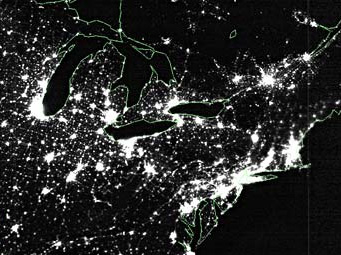No matter how long they've been at it, most amateur astronomers still crave two things: a larger telescope aperture and darker skies. And they'll also tell you that the former is far easier to get than the latter.

As seen from orbit, the nighttime view of the Northeast U.S. reveals a vast wasteland of light pollution stretching from Baltimore and Washington (lower left) to Boston (upper right).
NOAA / US Air Force
Still, there's hope for preserving what we have left of the starry sky. Awareness of light pollution and its deleterious effects on the "3Es" — energy, environment, and enjoying the night sky — has grown a lot in recent years.
One of the most visible dark-sky efforts has been GLOBE at Night. For the past four years, GaN has urged "citizen-scientists" around the world to estimate the darkness of their night sky by gauging how many stars are visible to the unaided eye in the constellation Orion.
Recently the GaN organizers released results of the 2009 effort, which ran during a moonless evening stretch from March 16th to 28th. The campaign garnered 15,300 observations, about 7,000 more than the previous record in 2007. (In 2008 the effort expanded its list of participating countries but tallied fewer observations than the previous year.) About 73% of those (11,270) came from the United States; skywatchers in Chile chipped in about 900 estimates, and the Czech Republic and United Kingdom each contributed more than 200.
Especially uplifting was a big jump in the number of high-quality electronic measurements (nearly 1,500 of them) made with handheld Sky Quality Meters. These handy, inexpensive gizmos accurately gauge the darkness of the sky overhead using a sensitive photocell.
The 2009 GaN campaign got a huge boost from the International Year of Astronomy, which made dark-sky awareness one of its 11 global "cornerstone projects." That said, I was struck by how much of the jump in estimates came from a single effort in and around Mishawaka, Indiana — not exactly a hotbed of astronomical research. There dark-sky activists Chuck Bueter and Art Klinger managed to mobilize the region's entire school system, it seems, to amass an incredible 3,400 measurements.
Soon, notes organizer Connie Walker (NOAO), you'll be able to peruse all the 2009 measurements at the GLOBE at Night website. For now, if you're curious, you can at least download all the estimates in .txt, .xls, or .csv formats. Getting timely results from the GaN effort has always been a problem because it's not a high priority with the Global Learning and Observations to Benefit the Environment (GLOBE) Program, which crunches all the numbers.
If your missed this year's campaign, there'll be another star-counting effort in October called the Great World Wide Star Count. And a European project called How Many Stars? is also under way.
 1
1
Comments
Nathaniel Sailor
May 19, 2009 at 6:14 pm
Keep it up with the awarness. Because if we're not careful we will lose what last dark sky areas we have. So send the awaraness around.
You must be logged in to post a comment.
You must be logged in to post a comment.